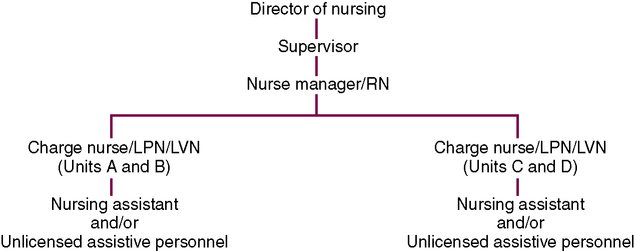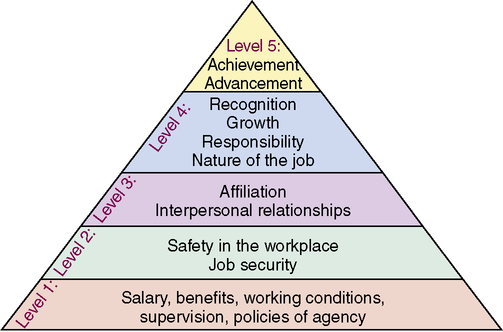On completing this chapter, you will be able to do the following: 1. Describe the expanded role of the practical/vocational nurse (LPN/LVN), as written in your state’s Nurse Practice Act. 2. Identify the location of the practical/vocational charge nurse on the organizational chart of a long-term care facility. 3. Explain the difference between leadership and management. 4. Identify your personal leadership style. 5. Explain the following leadership styles in your own words: 6. Identify ways to attain competency in the following five core areas, in which knowledge and skills are needed to be an effective first-line leader: a. Motivate team members to accomplish goals. d. Build a team of cooperative workers. 7. Identify ways to obtain competency in the following three specific areas, in which knowledge and skills are needed to be an effective first-line leader: 1) Nursing (clinical) skills, including the nursing process 4) Federal, state, and private organization regulations b) Continuous quality improvement b) Performance evaluations for nursing assistants 8. Describe how the Howlett Hierarchy of work motivators can help the practical/vocational nurse leader influence nursing assistants to motivate themselves. 9. Identify the importance of documenting objective, not subjective, charting entries in long-term care. 10. Use the problem-solving approach to set up a plan to solve a clinical problem. 11. Read the mission statement for your current area of clinical assignment. 12. Using suggestions in this chapter, write a plan that could be used to build a team to work on a long-term care unit. 13. Develop a plan to decrease stress in the clinical area. 14. Using the ABCD method of Ellis, identify an irrational thought you have had on the clinical area, and convert it to a rational thought. 15. In your own words, explain specific skills required of the practical/vocational charge nurse in long-term care because of Omnibus Reconciliation Act of 1987 (OBRA) regulations. 16. Prioritize tasks that need to be completed for your next clinical assignment. 17. Identify areas to improve efficiency in your current area of clinical assignment. 18. Practice giving positive and negative feedback, in measurable terms, to peers in a mock clinical situation. 19. Develop a plan for personal growth as a practical/vocational charge nurse. Practical/vocational nurses need to develop leadership and management skills so they can direct and supervise others in a manner that will effectively meet the goals of the employing agency. In your practical/vocational nursing program, you started to build a strong, solid base in these skills. This chapter and Chapter 21 will help you to continue to develop skills to lead and manage. This chapter focuses on the leadership role and provides 20 Leadership Hints, 5 Leadership Activities, and 1 Critical Thinking exercise to get you started thinking in a leadership mode. Chapter 21 provides 11 Management Hints, 12 Management Tools, and 7 Critical Thinking exercises to help you apply the knowledge and skills needed to be a charge nurse. The interactive format of both chapters, especially Chapter 21, will have you thinking as a new charge nurse and solving some of the problems new charge nurses face. This chapter and Chapter 21 can both be used as reference tools of skills while orienting to a practical/vocational charge nurse position. The organizational chart is a picture of responsibility in an employment situation. In the traditional organizational chart, individuals who are lower on the organizational chart report to the person directly above them on the chart. Figure 20-1 shows where the practical/vocational nurse fits into the traditional organizational chart as a first-line leader. In Figure 20-1, the practical/vocational nurse reports to the nurse manager, who is a registered nurse. Nursing assistants report to the practical/vocational nurse. To whom does the nurse manager report? Because of changes in the structure of organizations, organizational charts have become more horizontal than vertical in appearance. Figure 20-2 provides an example of a contemporary organizational chart. This “flattening out” has eliminated some of the middle manager positions in organizations. As a result, the remaining middle managers have taken on more responsibilities and are spread thin. Middle managers in this system have more persons reporting to them than in the past. Middle managers depend on the people who report to them, such as the practical/vocational charge nurse, to think critically and problem solve. Middle managers expect to be contacted when you have tried and are unable to solve your own problems. See the Coordinated Care, Leadership Activity: Examining Organizational Charts box. 1. Appendix A: NAPNES Standards of Practice and Educational Competencies of Graduates of Practical/Vocational Nursing Programs 2. Appendix B: NFLPN Nursing Practice Standards for the Licensed Practical/Vocational Nurse The most recent practice analysis of entry-level practical/vocational nurses by the National Council of State Boards of Nursing (NCSBN, 2010) for which data are available occurred in 2009. This survey identified that 45.2% of practical/vocational nurses responding to the survey reported they had administrative responsibilities, with 65.8% of these respondents working in long-term care. Fifty-two percent of respondents in long-term care reported the charge nurse position as their administrative responsibility. To carry out the first-line manager/charge nurse role effectively, you will need the abilities found in both a leader and a manager. The 2009 practice analysis can be obtained at www.ncsbn.org. 1. Basic nursing skills, including the nursing process 2. Time-management techniques for home and clinical time 3. How to learn new information, including using resources for learning 4. The power of positive self-talk and thinking 7. Ethical aspects of health care 8. Legal aspects of health care 9. Problem solving and critical thinking • The focus of management is planning and directing to meet patient goals. • Management is a formal role given to a person by the employer. • Managers are appointed by their employers. • The tools needed for management could be written in a step-by-step manner and given to you to follow. • Following the directions for using the management skills would possibly get the job done in an efficient manner. Leadership is the manner in which the leader gets along with coworkers and accomplishes the job. • The focus of leadership is to produce changes in the workplace that will meet the goals of the employing agency. • Leadership is an informal role that is given to a person by a group of workers. You become a leader when your team members decide to follow you. • Leaders cannot be appointed. • The leader needs to influence others in the work setting to want to implement desired change. • Directions for leadership skills can also be written, but it is through experience that leadership skills are truly developed. The literature abounds with examples of leadership styles. Figure 20-3 illustrates a continuum (a line with extreme opposites at each end) of leadership styles. Box 20-1 compares and contrasts the leadership styles found on this continuum. A purely task-centered leadership style (called autocratic style) thrives on power. It involves telling someone what to do, with little regard for the employee as a person who may have ideas about how to improve resident care or reach the goals of the employer. Adopting the autocratic or laissez-faire style in Box 20-1 to use consistently as a leadership style is unrealistic. Its consistent use could be disastrous. However, there is room for an autocratic leadership style—for example, in times of emergency. On the following lines, list two additional examples of situations that might require the autocratic style of leadership. The value of a continuum, as shown in Figure 20-3, is that as you move along the continuum from each extreme toward the center or midpoint, the two extremes begin to blend together. You have some of each style, depending on where you are on the continuum. A blend, to some degree, of the two extremes in the appropriate work situation would be the leadership style needed at the moment. • Abraham Maslow, a psychologist, presented a pyramid of human needs that ranks those needs and can assist the learner in understanding self and others (see Figure 10-1A). • Meeting needs on one level of the pyramid acts as a motivator for meeting the needs on the next level. • Progression through these levels is not clear-cut. In reality, as most of your needs are met on one level, you are already beginning to check out the next level. • When faced with overwhelming difficulties, physical or emotional, some regression takes place—for example: • Physiologic needs become a priority if you have lost your job or housing. • Safety and security needs become a major issue if you are facing a serious illness, move into an unsafe neighborhood, or are facing a divorce. • Once these issues have been dealt with or resolved, higher needs will reemerge. Maslow’s Hierarchy of Needs can be adapted to help the first-line LPN/LVN leader understand motivation of team members in a health care setting, based on needs (Figure 20-4). Remember, all behavior is internally motivated. As an LPN/LVN manager, you can influence what nursing assistants might be motivated to do. If nursing assistants see that doing a good job helps them meet personal needs, they will also be meeting the goals of their employer. All levels of the pyramid in Figure 20-4 are considered to be needs of employees in an employment situation. As you go up the Howlett Hierarchy, strategies could be used to encourage meeting needs of nursing assistants at each level. The opportunity to meet these needs can be encouraged or discouraged by the employer and/or the work environment, including the charge nurse (extrinsic motivators). If these needs are met, the person can proceed to the next highest level of the pyramid. If these needs are not met, a person may become dissatisfied with the work situation. Strategies for levels 3 and 4 can play an important role in motivation for team members at any level of the Howlett Hierarchy. Praise, recognition, and rewards are extremely important tools for leaders.
Leadership Skills
 http://evolve.elsevier.com/Hill/success
http://evolve.elsevier.com/Hill/success
Practical/vocational nurse as first-line leader
Organizational chart


Expanded role of practical/vocational nursing
Preparing for a leadership and management role
Difference between management and leadership
Leadership styles

Benefits and disadvantages of leadership styles
Using the leadership continuum as a guide
Core knowledge and skills needed for leadership
Understanding motivation and human needs
Human Needs
Motivating Nursing Assistants


Leadership Skills
Get Clinical Tree app for offline access








